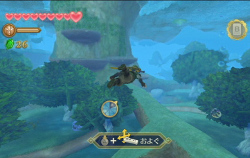Skyward Sword’s Brilliant Overworld Design
Posted on May 11 2012 by Hanyou
 One of the first notable things about Skyward Sword’s overworld — even the developers advertised this — was its dungeon-like design. It was compartmentalized, claustrophobic, and packed with puzzles and action at every turn. There was little room for passivity; the sailing and open fields of past 3D Zelda games gave way to a more frantic but more focused approach. By no means was this approach better, but it fit both the tone and the gameplay choices that pervaded all of Skyward Sword, and is a product of skillful design. It also allowed the plot to unfold gradually within the constantly developing world and encouraged new ways to play that still felt familiar.
One of the first notable things about Skyward Sword’s overworld — even the developers advertised this — was its dungeon-like design. It was compartmentalized, claustrophobic, and packed with puzzles and action at every turn. There was little room for passivity; the sailing and open fields of past 3D Zelda games gave way to a more frantic but more focused approach. By no means was this approach better, but it fit both the tone and the gameplay choices that pervaded all of Skyward Sword, and is a product of skillful design. It also allowed the plot to unfold gradually within the constantly developing world and encouraged new ways to play that still felt familiar.
To those who’ve played other 3D Zelda games, and especially those of us who were introduced to Zelda or gaming in general with games like Ocarina of Time and The Wind Waker, the approach might have felt brand new. But it’s obvious that it echoes past Zelda games, specifically the two-dimensional ones which are widely regarded as classics. What sets it apart is its implementation and design.
Skyward sword is an action game, and everything about the game — from its Wii Motion Plus-focused control scheme to its focus on combat — makes this abundantly clear. But most importantly, and perhaps least immediately obvious, is the overworld design, which funnels the player through countless motion-based challenges seamlessly integrated into a linear quest. This is not a Zelda game designed with openness in mind. It is, arguably, not even a Zelda game that feels like it’s designed to house a living, breathing world. Instead, its focus on raw action gameplay rewards not exploration, but maximization of the resources and items that the game constantly throws at the player. It’s a system of punishment and reward that needs refined, artful gameplay to provide an enjoyable experience.
In the process, it borrows ideas liberally from past Zelda games, but applies them differently. In the original Legend of Zelda and A Link to the Past, a variety of gameplay styles were possible in the overworld, and they felt spontaneous, not programmed. A Link to the Past had a fair amount of stealth gameplay; there was no shortage of opportunities to dodge and strategize when navigating around enemies, and it helped that your health was constantly threatened in the early stages of the game.
Skyward Sword earnestly implemented that for what felt like the first time in a 3D Zelda game. This is partly due to the combat system itself, which is fast-paced, strategic, and wholly different from that of any other Zelda game, but without an overworld that complemented the gameplay, it simply wouldn’t have been successful.

The design of each area appears at first to be labyrinthine. Visiting each area for the first time, it’s easy enough to get lost and turned around, especially in the similar-looking central area of Faron Woods. The first trek through Lanayru Desert is certainly confusing, and offers a host of new gameplay ideas to supplement the experience, along with forcing the player to rely on the map while constantly contending with the quicksand scattered about. Eldin Volcano offers more obvious variety than either of the other regions, with a segmented approach that utilizes fetch quests in its limited space.
One of the brilliant things about this design is that as the player advances through the game, they will no doubt become intimately familiar with each of the individual regions. This is because they’re constantly being repurposed and expanded, and the plot-based expansions are offered up one at a time so that there’s always something more to an area. One trek through Faron Woods won’t show you everything it has to offer, and you probably won’t guess at the flooding that occurs later in the game, or the implications it has for the gameplay. The tightly-packed caves and towering walls, complete with platformer-style gameplay, that marked the early regions of Lanayru Desert couldn’t have prepared us for the more open, entirely different Sand Sea. And it’s unlikely most would have guessed, when navigating the initial challenges of Eldin Volcano, that the area was designed with stealth in mind, and was later to be littered with enemies that actively hunted a vulnerable Link, stripped of items, at every turn.
These regions were designed for variety, and by the end of the game it felt like the designers knew this was important and made the overworld first; The overworld was a response to gameplay ideas, but it also fed them. You had exactly the sort of experience the game designers wanted you to have when you played Skyward Sword, and it was an experience of varied but well-developed gameplay supplemented by a clever and evolving plot. Perhaps more than any Zelda game before it, Skyward Sword’s world felt like it responded to every item Link obtained and every small twist in the story, so that by the end it was fundamentally cinematic.
 What was missing from this overworld was player input and a sense of discovery, which is basic to the Zelda experience. By focusing their ideas and patterning the world, the developers allowed it to take on all the traits necessary to distinguish Skyward Sword from its predecessors. Perhaps in the future, however, Zelda overworlds would benefit from a more mixed set of gameplay ideas. Skyward Sword echoes the 2D games’ overworld, but adds to it by constantly developing and changing things about the overworld. What would it feel like if this development was supplemented by the kind of player input that made A Link to the Past or even the more contemporary The Minish Cap stand out?
What was missing from this overworld was player input and a sense of discovery, which is basic to the Zelda experience. By focusing their ideas and patterning the world, the developers allowed it to take on all the traits necessary to distinguish Skyward Sword from its predecessors. Perhaps in the future, however, Zelda overworlds would benefit from a more mixed set of gameplay ideas. Skyward Sword echoes the 2D games’ overworld, but adds to it by constantly developing and changing things about the overworld. What would it feel like if this development was supplemented by the kind of player input that made A Link to the Past or even the more contemporary The Minish Cap stand out?
In any case, Skyward Sword, with its action focus, would not be nearly as good as it is if it didn’t have an overworld which held up its ideas. The concepts introduced in the three major regions should be celebrated as a milestone for Zelda that drew on classic ideas and introduced new ones. Perhaps Nintendo can find a clearer path for the future by looking back at some of the things that made previous overworlds as great as they were.




